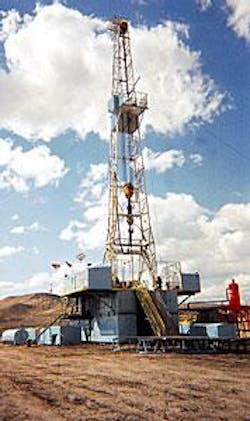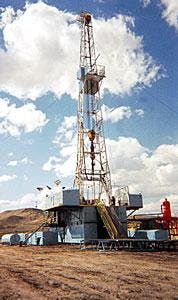Lower natural gas prices may dent US drilling
DRILLING MARKET FOCUS
Tropical Storm Bill had little effect on drilling and other oil field operations as it moved through the central Gulf of Mexico and came ashore in Louisiana on June 30, but it remains to be seen how the industry will weather the recent drop in natural gas prices.
Although the storm produced power outages and flooded some low-lying areas ashore, the US Minerals Management Service reported only moderate disruption in oil and natural gas operations in the gulf as a result of the storm.
Officials reported some 250 MMcfd of gas output were shut in by producers because of the storm, less than 2% of the 14 bcfd of gas produced from offshore fields (OGJ Online, July 2, 2003).
Baker Hughes Inc. reported the number of rotary rigs working in Louisiana and its waters actually increased by 3 to 157, the biggest gain that week among the major producing states (OGJ Online, July 3, 2003).
Natural gas prices
As Tropical Storm Bill lashed the Louisiana coast, the August natural gas contract inched up by 4.9¢ to $5.41/Mcf that same day on the New York Mercantile Exchange. Even that slight increase was not stimulated by the storm, however; instead, the gas futures market simply followed the spot natural gas cash market and oil prices higher. In subsequent sessions, that contract dropped to nearly a 3-month low ahead of the a long 4th of July holiday weekend.
The decline in natural gas futures prices was spurred by three consecutive weekly reports from the US Energy Information Administration of natural gas injections exceeding 100 bcf into US underground storage, culminating in a record injection of 127 bcf during the week ended June 20.
null
In the following week through June 27, gas injections dipped to 97 bcf, with about 1.7 tcf of gas in storage at the end of June, 624 bcf less than in the same period of 2002 and 348 bcf below the 5-year average.
"We now know this summer's equilibrium price is not as high as $6[/Mcf]," said Stephen Smith, founder and president of Stephen Smith Energy Associates, Natchez, Miss., in a July 7 report. "With gas prices now approaching $5 and possibly lower levels [depending on summer weather], gas is beginning to be competitively priced again and 'demand destruction' will continue to ease," he predicted.
"This oscillatory price behavior is typical of the normal process of searching for a new equilibrium price following a fundamental change in the underlying supply-demand balance," Smith said. "Recent events suggest that prices may not spend much time below $5[/Mcf]."
Drilling trend
"The general trend in US gas drilling activity over the last year has been one of recovering development activity, but weakening exploration activity," said Paul Horsnell, J.P. Morgan Securities Inc., London, in a July 3 report.
"A situation where companies are prepared to develop but not explore does raise some questions about the quality of what is being developed, with the suggestion being that the incremental projects may by and large be smaller than usual and liable to play out quickly," he said.
During the last full week of June, Horsnell said, US gas development drilling was 17.4% higher than during the same period in 2002, but gas exploration was 19% less. Oil development drilling during the final full week of June was up 42.9% from June 2002, while oil exploration was unchanged. Oil drilling on federal offshore acreage in the Gulf of Mexico remained at zero during that week, Horsnell said.
Demand for mobile offshore rigs in the Gulf of Mexico remained soft, with three units leaving those waters for other markets during the week ended June 27, said officials at ODS-Petrodata, Houston.
Deepwater market
The deepwater drilling market for rigs capable of working in water depths greater than 4,500 ft "will be soft for at least the next 12 months" as a result of "a shortage of projects that will utilize the full capabilities of these rigs, which will lead to lower day rates," said analysts at UBS Warburg LLC, New York.
"The deepwater rig market has moved out of balance over the past year, and based on our research, we believe the amount of available supply will worsen over the next 6-12 months," said James Stone, managing director, oil field services equity research, for UBS Investment, in a June 24 report.
Demand for deepwater rigs is rising, but not as fast as supply, Stone claimed. "While it is relatively easy to quantify the available supply by looking at the contract status of each rig, there is a more subtle change in rig supply that has been ongoing for the past 2 years and is likely to continue to be a factor over the next several years," he said.
Stone defines that factor as "capacity creep," resulting from "a combination of several factors and forces, which result in a growing number of available rig days." It's part of "a broad-based industry effort, primarily among the service companies, to develop new technology to improve drilling efficiency and reduce rig time, particularly in deep water," he said.
"Some of these initiatives are aimed at extending the water depth of smaller rigs [through the use of] alloy risers, subsea mudlift drilling, and smaller blowout preventers," said Stone. "Other technology is focused on the well construction process, better equipment for drilling wells (drill bits, fluid systems, expandable tubulars) or better information technology (incident avoidance software, online maintenance capabilities).
"All of these efforts are reducing the time it takes to drill wells," he said. "Yet we do not believe that just because an oil company can drill wells faster, that company will necessarily drill more wells." For deepwater projects, said Stone, the decisive factor is not how quickly a well can be drilled but rather the "engineering resources and prospect development capacity."
There are 70 total semisubmersible rigs and drillships capable of drilling in water depths greater than 4,000 ft, plus "another 4 newbuilds that are scheduled to enter the fleet by the middle of 2005," Stone said. As of late June, he said, "Only 14% of these deepwater units are uncontracted, but that figure is expected to rise sharply to 30% for the third quarter of 2003 and 43% by the end of the fourth quarter of this year." That could change, he said, "if operators decide to extend contracts."
Looking at the market for deepwater rigs by water depth classification, Stone said, the lower—or "'regular' deep"—end of the market, including rigs capable of working in depths of 4,000-7,000 ft, "appears to be the most oversupplied." The ultradeep market for rigs capable of working in depths greater than 8,000 ft "looks like it will remain pretty tight, even at the low end of our demand forecast," he reported.
Because deepwater rigs "are generally newer and have greater drilling efficiencies than other floating rigs, even in shallower waters," many will likely find work in those reduced depths, "which will keep utilization rates relatively high," said Stone.
Because of the competition in the mid-water floating-rig market, however, "day rates will likely suffer when these deepwater rigs work in shallower water."
Stone foresees "sufficient demand for a handful of ultradeep units, such that day rates should not deteriorate much from current levels, and rates in excess of $150,000/day are quite possible."
Day rates for some rigs rated for 4,000-5,000 ft, however, could drop "as low as $70,000/day," he said, "although we believe that most new contract fixtures will be in the range of $90,000-120,000[/day] for the next 12 months."
That would put day rates "well above cash costs for the rigs, but well below what is necessary for most of these rigs to earn an adequate return on capital employed, particularly the newbuilds," Stone said.

